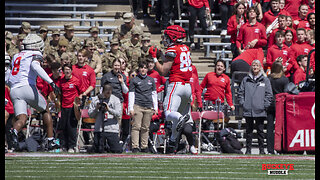Premium Only Content

A beautiful universe with all its splendor, shown through telescope photography with beautiful background music.
The Hubble Space Telescope (HST) is a space telescope that was launched into low Earth orbit in 1990, and remains in operation. Although not the first space telescope, Hubble is one of the largest and most versatile, and is well known as both a vital research tool and a public relations boon for astronomy.
The HST is named after the astronomer Edwin Hubble, and is one of NASA's Great Observatories, along with the Compton Gamma Ray Observatory, the Chandra X-ray Observatory, and the Spitzer Space Telescope.
With a 2.4-meter (7.9 ft) mirror, Hubble's four main instruments observe in the near ultraviolet, visible, and near infrared spectra. Hubble's orbit outside the distortion of Earth's atmosphere allows it to take extremely high-resolution images, with substantially lower background light than ground-based telescopes.
Hubble has recorded some of the most detailed visible light images ever, allowing a deep view into space and time. Many Hubble observations have led to breakthroughs in astrophysics, such as accurately determining the rate of expansion of the universe. The HST was built by the United States space agency NASA, with contributions from the European Space Agency.
The Space Telescope Science Institute (STScI) selects Hubble's targets and processes the resulting data, while the Goddard Space Flight Center controls the spacecraft. Space telescopes were proposed as early as 1923.
Hubble was funded in the 1970s, with a proposed launch in 1983, but the project was beset by technical delays, budget problems, and the Challenger disaster (1986). When finally launched in 1990, Hubble's main mirror was found to have been ground incorrectly, compromising the telescope's capabilities.
The optics were corrected to their intended quality by a servicing mission in 1993. Hubble is the only telescope designed to be serviced in space by astronauts. After launch by Space Shuttle Discovery in 1990, four subsequent Space Shuttle missions repaired, upgraded, and replaced systems on the telescope.
A fifth mission was canceled on safety grounds following the Columbia disaster (2003).
However, after spirited public discussion, NASA administrator Mike Griffin approved one final servicing mission, completed in 2009.
The telescope is operating as of 2016, and could last until 2030–2040. Its scientific successor, the James Webb Space Telescope (JWST), is scheduled for launch in 2018.
-
 1:36
1:36
Nick Shirley
6 hours agoThese Anti-Trump and Elon Protesters are Idiots
1728 -
 17:08
17:08
World2Briggs
1 day ago $0.06 earned10 Worst Cities to Move if You Hate Yourself.
1141 -
 13:32
13:32
megimu32
1 day agoKitKat vs. Twix: One Breaks, One Bites… Who Wins?
2257 -
 24:04
24:04
Link to the Light
18 hours agoTop 10 Most Anticipated Games of 2025 - Link to the Light
562 -
 23:00
23:00
Ohio State Football and Recruiting at Buckeye Huddle
17 hours agoOhio State Football: Spring Game Recap | Biggest Concerns for Buckeyes?
18 -
 11:57
11:57
Fit'n Fire
4 hours ago $0.01 earnedGriffin Armament Dual-Lok HRT-762 First Looks
62 -
 11:23
11:23
ariellescarcella
1 day agoHere's What Happens To 'Trans Kids' : 15 Year Study Reveals ALL
3309 -
 1:04
1:04
Memology 101
2 hours ago $0.02 earnedOut of touch MULTI-MILLIONAIRE wants YOU paying MORE TAXES to own Trump
1856 -
 13:24
13:24
Talk Nerdy Sports - The Ultimate Sports Betting Podcast
4 hours ago4/13/25 - Sunday Strike Team: Tactical Bets, Brutal Truths, Full Redemption
18.2K2 -
 1:11:33
1:11:33
Wendy Bell Radio
11 hours agoWeekends With Wendy
78.7K184